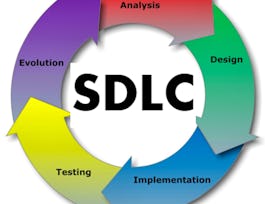This comprehensive course on Secure Software Development is designed to help IT professionals integrate security at every stage of the Software Development Life Cycle (SDLC), following the CISSP curriculum. The course starts with an introduction to security considerations in software development and how to choose the appropriate development methodology, including process-driven and agile-based approaches. You’ll explore the use of security controls, risk analysis, and methodologies such as the Capability Maturity Model (CMM) and Software Assurance Maturity Model (SAMM) to enhance the security of your development processes.



Secure Software Development
This course is part of CISSP Certified Information Systems Security Professional Specialization

Instructor: Packt - Course Instructors
Sponsored by Coursera Learning Team
Recommended experience
What you'll learn
Apply secure coding standards to reduce vulnerabilities at the source-code level.
Conduct comprehensive application security testing and manage post-deployment risks effectively.
Implement auditing, logging, and change management processes to ensure secure software development and maintenance.
Assess the security of third-party, open-source, and cloud-based software to identify and mitigate potential risks.
Details to know

Add to your LinkedIn profile
1 assignment
October 2024
See how employees at top companies are mastering in-demand skills

Build your subject-matter expertise
- Learn new concepts from industry experts
- Gain a foundational understanding of a subject or tool
- Develop job-relevant skills with hands-on projects
- Earn a shareable career certificate


Earn a career certificate
Add this credential to your LinkedIn profile, resume, or CV
Share it on social media and in your performance review

There are 2 modules in this course
This module focuses on the integration of security into the Software Development Life Cycle (SDLC) and selecting appropriate development methodologies. Learners will explore how to choose secure software development methods, including both process-driven and agile-based approaches. This module will also cover frameworks such as Capability Maturity Model (CMM) and SAMM, and the role of Integrated Product Teams (IPT) in improving the quality and security of software products. By mastering these concepts, learners will be able to implement secure practices throughout the development lifecycle.
What's included
8 videos2 readings
This module emphasizes secure coding practices, software configuration management, and application security testing within the SDLC. Learners will delve into risk analysis, mitigating programming language risks, and evaluating security in various software environments, including third-party, open-source, and cloud-based software. The module also covers API security, auditing, and logging of software changes. By mastering these areas, learners will be able to develop, deploy, and maintain secure software while managing associated risks.
What's included
14 videos1 reading1 assignment
Instructor

Offered by
Why people choose Coursera for their career




Recommended if you're interested in Computer Science

The Linux Foundation

University of Minnesota

Open new doors with Coursera Plus
Unlimited access to 10,000+ world-class courses, hands-on projects, and job-ready certificate programs - all included in your subscription
Advance your career with an online degree
Earn a degree from world-class universities - 100% online
Join over 3,400 global companies that choose Coursera for Business
Upskill your employees to excel in the digital economy




